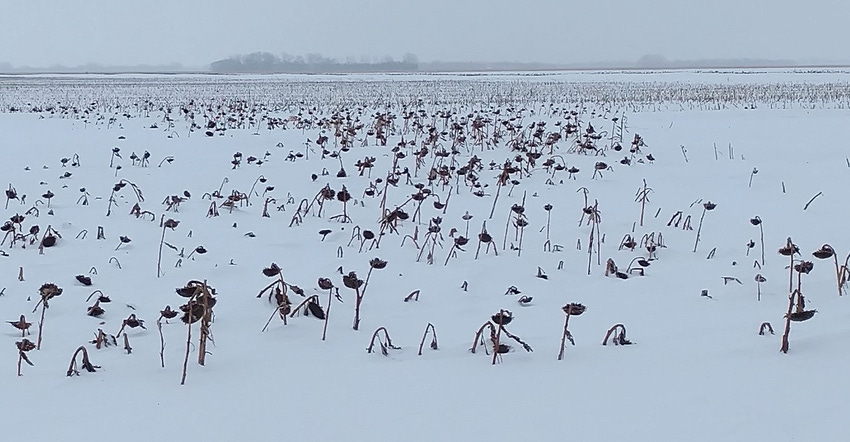
Despite the extremely challenging 2019 growing season, USDA recently delivered 2019 production estimates for both oil-type and confection sunflower that were well above industry expectations.
High moisture seed and cold weather hampered harvest progress in the largest production area of the Dakotas and Minnesota. With soggy weather conditions at harvest, traders anticipated much lower production figures. Plus, 20% of the crop was still in field when the report was released.
Because USDA included unharvested area and expected production in the totals in the report, take these figures with a grain of salt.
According to USDA, 2019 sunflower production totaled 1.94 billion pounds, down 8% from 2018. The U.S. average yield per acre of 1,562 pounds decreased 169 pounds from 2018. Planted area, at 1.35 million acres, was 4% above the previous year. Area harvested increased 2% from 2018 to 1.24 million acres.
South Dakota No. 1 again
South Dakota regained its status as the leading sunflower producing state during 2019, with total production of 832 million pounds. Compared with 2018, planted area in South Dakota decreased 7% and yield decreased 146 pounds to 1,694 pounds per acre.
Meanwhile, production in North Dakota increased slightly primarily due to planted acreage, which increased 23% from the previous year. The average yield in North Dakota decreased 242 pounds from 2018 to 1,518 pounds per acre.
USDA estimated U.S. production of oil-type sunflower varieties, at 1.75 billion pounds, representing a decrease of 7% from 2018. Compared with last year, harvested acres were down 2% and the average yield decreased by 163 pounds to 1,562 pounds per acre.
Production of confection sunflower varieties was estimated at 197 million pounds, a decrease of 10% from last year. Area harvested, at 126,500 acres, is up 3% from 2018. The average yield decreased by 223 pounds to 1,558 pounds per acre.
Prices up
The sunflower market has been following the trend of stronger oil values. Oil stocks are tighter than a year ago, and there are some concerns for palm oil production this year as weather reduces overall production. This scenario looks promising for high oil content seeds such as sunflower. This, in combination with reserved producer selling and slower seed deliveries, has led to nearby prices adding $2.00 to $2.50 per cwt at the crush plants since harvest began.
It is very possible that the market low has already been established and prices will remain relatively firm for the foreseeable future.
Also, new crop sunflower prices are penciling out well as crushers and confection processors are out with attractive 2020 production contracts. The market will be aggressive to get acres this year as stocks will be tight come September due to smaller 2019 production.
Another thing to consider is that with sunflower contracts, you have the Act of God clause which is helpful to lock in a profitable price and reduce some risk. To keep up with price movement you can go to sunflowernsa.com.
Sandbakken is the executive director of the National Sunflower Association.
Read more about:
SunflowersAbout the Author(s)
You May Also Like






